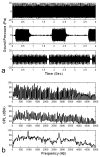In situ active control of noise in a 4 T MRI scanner
- PMID: 21751284
- PMCID: PMC3193878
- DOI: 10.1002/jmri.22694
In situ active control of noise in a 4 T MRI scanner
Abstract
Purpose: To evaluate the effectiveness of the proposed active noise control (ANC) system for the reduction of the acoustic noise emission generated by a 4 T MRI scanner during operation and to assess the feasibility of developing an ANC device that can be deployed in situ.
Materials and methods: Three typical scanning sequences, EPI (echo planar imaging), GEMS (gradient echo multislice), and MDEFT (modified driven equilibrium Fourier transform), were used for evaluating the performance of the ANC system, which was composed of a magnetic compatible headset and a multiple reference feedforward filtered-x least mean square controller.
Results: The greatest reduction, about 55 dB, was achieved at the harmonic at a frequency of 1.3 kHz in the GEMS case. Approximately 21 dB and 30 dBA overall reduction was achieved for GEMS noise across the entire audible frequency range. For the MDEFT sequence, the control system achieved 14 dB and 14 dBA overall reduction in the audible frequency range, while 13 dB and 14 dBA reduction was obtained for the EPI case.
Conclusion: The result is highly encouraging because it shows great potential for treating magnetic resonance imaging noise with an ANC application during real-time scanning.
Copyright © 2011 Wiley-Liss, Inc.
Figures




 : baseline response;
: baseline response;
 : controlled response).
: controlled response).

 : baseline response;
: baseline response;
 : controlled response).
: controlled response).

 : baseline response;
: baseline response;
 : controlled response).
: controlled response).
Similar articles
-
Adaptive speech enhancement using directional microphone in a 4-T MRI scanner.MAGMA. 2015 Oct;28(5):473-84. doi: 10.1007/s10334-015-0485-4. Epub 2015 Apr 18. MAGMA. 2015. PMID: 25894814
-
Simulation study on active noise control for a 4-T MRI scanner.Magn Reson Imaging. 2008 Apr;26(3):393-400. doi: 10.1016/j.mri.2007.08.003. Epub 2007 Dec 3. Magn Reson Imaging. 2008. PMID: 18060719 Free PMC article.
-
The use of active noise control (ANC) to reduce acoustic noise generated during MRI scanning: some initial results.Magn Reson Imaging. 1997;15(3):319-22. doi: 10.1016/s0730-725x(96)00337-2. Magn Reson Imaging. 1997. PMID: 9201679
-
Acoustic noise in a small-format 3.0-T neonatal MRI system.Pediatr Radiol. 2024 Nov;54(12):2068-2076. doi: 10.1007/s00247-024-06070-9. Epub 2024 Oct 15. Pediatr Radiol. 2024. PMID: 39404888
-
A Review of MRI Acoustic Noise Outputs and Hearing Protection Device Performance.J Magn Reson Imaging. 2025 May;61(5):2083-2093. doi: 10.1002/jmri.29665. Epub 2024 Dec 17. J Magn Reson Imaging. 2025. PMID: 39690111 Review.
Cited by
-
Methodological challenges and solutions in auditory functional magnetic resonance imaging.Front Neurosci. 2014 Aug 21;8:253. doi: 10.3389/fnins.2014.00253. eCollection 2014. Front Neurosci. 2014. PMID: 25191218 Free PMC article. Review.
-
Gradient and shim technologies for ultra high field MRI.Neuroimage. 2018 Mar;168:59-70. doi: 10.1016/j.neuroimage.2016.11.033. Epub 2016 Nov 30. Neuroimage. 2018. PMID: 27915120 Free PMC article. Review.
-
Adaptive speech enhancement using directional microphone in a 4-T MRI scanner.MAGMA. 2015 Oct;28(5):473-84. doi: 10.1007/s10334-015-0485-4. Epub 2015 Apr 18. MAGMA. 2015. PMID: 25894814
-
A Numerical Systematic Review and Meta-Analysis of Diagnosing the Vibration Modes of the Cylindrical Shell in the MRI Machine.Biomed Eng Comput Biol. 2025 Jul 10;16:11795972251353069. doi: 10.1177/11795972251353069. eCollection 2025. Biomed Eng Comput Biol. 2025. PMID: 40657491 Free PMC article. Review.
-
Overview of Methods for Noise and Heat Reduction in MRI Gradient Coils.Front Phys. 2022 Jul;10:907619. doi: 10.3389/fphy.2022.907619. Epub 2022 Jul 8. Front Phys. 2022. PMID: 36506821 Free PMC article.
References
-
- Hurwitz R, Lane S, Bell RA, Zawadzki MN. Acoustic analysis of gradient coil noise in MR imaging. Radiology. 1989;173:545–548. - PubMed
-
- More SR, Lim TC, Li M, Holland CK, Boyce SE, Lee J-H. Acoustic noise characteristics of a 4 Tesla MRI scanner. J Magn Reson Imaging. 2006;23:388–397. - PubMed
-
- Gangarosa RE, Minnis JE, Nobbe J, Praschan D, Genberg RW. Operational safety issues in MRI. Magn Reson Imaging. 1987;5 :287–92. - PubMed
-
- Quirk ME, Letendre A, Ciottone RA, Lingley JF. Anxiety in patients undergoing imaging. Radiology. 1989;170:463–466. - PubMed
Publication types
MeSH terms
Grants and funding
LinkOut - more resources
Full Text Sources
Other Literature Sources
Medical
Miscellaneous

